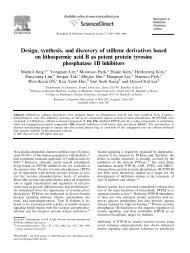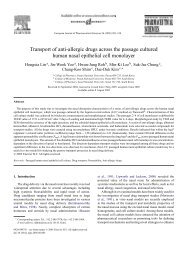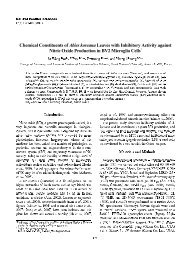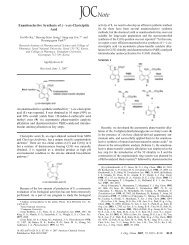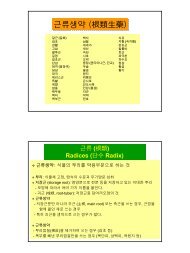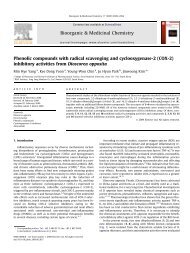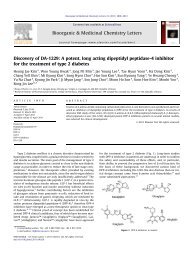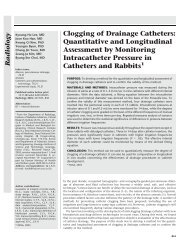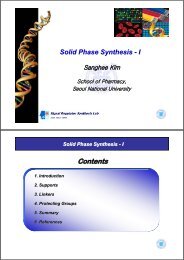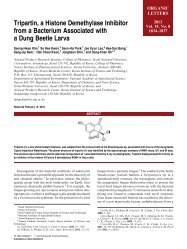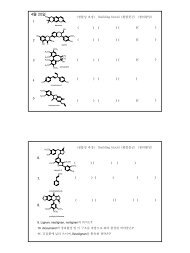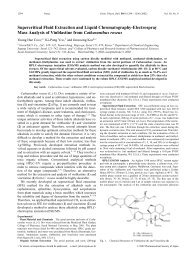Chapter 2 Water
Chapter 2 Water
Chapter 2 Water
Create successful ePaper yourself
Turn your PDF publications into a flip-book with our unique Google optimized e-Paper software.
18<br />
<strong>Chapter</strong> 2 <strong>Water</strong><br />
<strong>Chapter</strong> 2 <strong>Water</strong> 19<br />
27. Weak interactions in aqueous systems<br />
Pages: 51–52 Difficulty: 2<br />
(a) Briefly define “isotonic,” “hypotonic,” and “hypertonic” solutions. (b) Describe what happens<br />
when a cell is placed in each of these types of solutions.<br />
Ans: (a) An isotonic solution has the same osmolarity as the solution to which it is being compared. A<br />
hypotonic solution has a lower osmolarity than the solution to which it is being compared. A<br />
hypertonic solution has a higher osmolarity than the solution to which it is being compared. (b) Higher<br />
osmolarity results in osmotic pressure, which generally leads to movement of water across a membrane.<br />
In an isotonic solution, in which the osmolarity of the solution is the same as the cell cytoplasm, there<br />
will be no net water movement. In a hypotonic solution, water will move into the cell, causing the cell<br />
to swell and possibly burst. In a hypertonic solution, water will move out of the cell and it will shrink.<br />
28. Ionization of water, weak acids, and weak bases<br />
Page: 57 Difficulty: 1<br />
For each of the pairs below, circle the conjugate base.<br />
RCOOH RCOO –<br />
RNH 2 RNH 3<br />
+<br />
H 2 PO 4<br />
–<br />
H 3 PO 4<br />
H 2 CO 3 HCO 3<br />
–<br />
Ans: RCOO – , RNH 2 , H 2 PO 4 – , HCO 3<br />
–<br />
29. Ionization of water, weak acids, and weak bases<br />
Page: 57 Difficulty: 2<br />
Phosphoric acid (H 3 PO 4 ) has three dissociable protons, with the pK a ’s shown below. Which form of<br />
phosphoric acid predominates in a solution at pH 4 Explain your answer.<br />
Acid pK a<br />
H 3 PO 4 2.14<br />
H 2 PO 4<br />
–<br />
HPO 4<br />
2–<br />
6.86<br />
12.4<br />
31. Buffering against pH changes in biological systems<br />
Page: 58–60 Difficulty: 2<br />
Give the general Henderson-Hasselbalch equation and sketch the plot it describes (pH against amount<br />
of NaOH added to a weak acid). On your curve label the pK a for the weak acid, and indicate the region<br />
in which the buffering capacity of the system is greatest.<br />
Ans: The inflection point, which occurs when the weak acid has been exactly one half titrated with<br />
NaOH, occurs at a pH equal to the pK a of the weak acid. The region of greatest buffering capacity<br />
(where the titration curve is flattest) occurs at pH values of pK a ±1. (See Fig. 2-17, p. 59.)<br />
32. Buffering against pH changes in biological systems<br />
Pages: 59–60 Difficulty: 3<br />
Draw the titration curve for a weak acid, HA, whose pK a is 3.2. Label the axes properly. Indicate with<br />
an arrow where on the curve the ratio of salt (A – ) to acid (HA) is 3:1. What is the pH at this point<br />
Ans: The plot of pH vs. added base should have the general shape of those shown in Fig. 2-17, p. 59,<br />
with the midpoint of the titration (inflection point) at pH 3.2. The ratio of A – to HA is 3 when 0.75<br />
equivalents of base have been added. From the Henderson-Hasselbalch equation, the pH at this point<br />
can be calculated:<br />
[conjugate base]<br />
pH = pK a + log<br />
= 3.2 + log 3 = 3.2 + 0.48 = 3.68<br />
[acid]<br />
33. Buffering against pH changes in biological systems<br />
Page: 61–62 Difficulty: 2<br />
What is the pH of a solution containing 0.2 M acetic acid (pK a = 4.7) and 0.1 M sodium acetate<br />
Ans:<br />
pH = pK a + log<br />
= 4.7 – 0.3 = 4.4<br />
[conjugate base]<br />
= 4.7 + log (0.1/0.2)<br />
[acid]<br />
34. Buffering against pH changes in biological systems<br />
Page: 61–62 Difficulty: 2<br />
You have just made a solution by combining 50 mL of a 0.1 M sodium acetate solution with 150 mL of<br />
1 M acetic acid (pK a = 4.7). What is the pH of the resulting solution<br />
Ans: At pH 4, the first dissociable proton (pK a = 2.14) has been titrated completely, and the second (pK a<br />
= 6.86) has just started to be titrated. The dominant form at pH 4 is therefore H 2 PO 4 – , the form with one<br />
dissociated proton (see Fig. 2-15).<br />
30. Ionization of water, weak acids, and weak bases<br />
Page: 58–59 Difficulty: 1<br />
Define pK a for a weak acid in the following two ways: (1) in relation to its acid dissociation constant,<br />
K a , and (2) by reference to a titration curve for the weak acid.<br />
Ans: (1) pK a = –log K a ; (2) See Fig. 2-17, p. 59; pK a is the value of pH at the inflection point in a plot<br />
of pH vs. extent of titration of the weak acid. At the pK a , the concentration of ionized acid equals the<br />
concentration of un-ionized acid.<br />
Ans:<br />
pH = pK a + log<br />
= 4.7 – 1.48 = 3.22<br />
[conjugate base]<br />
= 4.7 + log (5/150)<br />
[acid]



